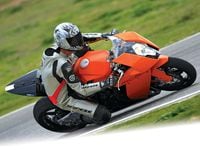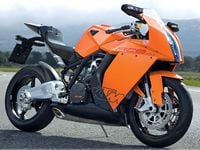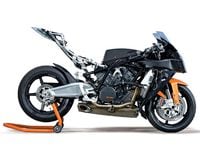The day with KTM's long-awaited superbike had held a few surprises. I'd spent the afternoon carving the 1190 RC8 around southern Spain's Ascari circuit, where its power, handling and overall ability had been mighty impressive. That much was predictable. Less so is the V-twin's addictive low-end punch that revealed itself on the morning's road ride as we swept down curvy roads to the ancient town of Ronda. The RC8's look and KTM's competition background had suggested a hard, supremely focused machine built more for the track than the road. But the day's riding had shown the RC8 to be more comfortable and well rounded than it appears.
My test began on the road, with a white example set up for that express purpose. With the bike's adjustable ergonomics tailored for maximum room, I was surprised by how comfortable it feels. The reasonably high clip-ons and the short distance between bars and seat add up to a relatively relaxed riding position and less weight on the wrists than on many sportbikes. The seat is comfortable, too-though it remains to be seen how a passenger fits on that screw-on perch.
Heading into the hills west of Ronda with the suspension soaking up the bumps, the windscreen provides more protection than most. KTM's sporting flagship steers sweetly with little effort, feeling reassuringly rider-friendly all the while. Just remember this is a tiger, not a pussycat. Tweaking the light-action throttle sends it leaping viciously forward with a deep growl from the single muffler slung beneath the engine.
Grab a handful of throttle and there's no time to check the quick-jabbing bar on the LCD tach. The big V-twin just rips forward, propelling its claimed 414 pounds (sans gas) with a wide spread of torque that puts big numbers on the digital speedo in very little time.
Abrupt low-rpm fueling and a light, quick throttle make for jerky progress through the tight Sierra de Ronda hairpins. Beyond that a broad, essentially seamless spread of power pushes you toward the 10,400-rpm redline in all six gears, en route to a likely top speed of about 170 mph. Whether the RC8 is as rapid as Ducati's 1098 remains to be seen-but it will certainly put up a fight.
Aside from a couple of niggles, finish and function measure up to KTM's normally high standards. The six-speed gearbox is good, but not great. I caught neutral instead of second a few times shifting up from the tall first gear. Although the lever can be adjusted for length, angle and sensitivity, no amount of fine-tuning could perfect that shift. But since the bikes we rode were very new, some break-in time might help.
My other gripe is vibration. Most of the time there's just enough to add a little V-twin character, but the buzz at 7000 rpm is enough to blur rear-view mirror images and turn your fingers numb. Twin balance shafts aren't quite enough to calm the solidly mounted motor.
The RC8 will wheelie if provoked, but this bike is built for speed, not stunts. Forward-biased weight distribution conspires with the extra-long swingarm's carefully chosen pivot point to keep the front wheel planted on the pavement, even under hard acceleration.
Such stability would come in handy later in the day at Ascari, where the RC8 charges out of the slower turns at a thrilling rate. The picturesque but tricky circuit has plenty of blind bends, cambers and gradients, but the RC8's flexible engine, easy handling, stability and stopping power make the bike forgiving as well as fast.
The thoughtful KTM technicians dropped the bars, raised the footpegs and firmed up the suspension for our track sessions. The result behaved quite well-and even better with a couple clicks of rebound damping in the 43mm WP fork. The added stability up front let me make the most of those four-pot Brembo Monobloc radial front brake calipers, which grip their 320mm discs with enormous force; slightly less than the Ducati 1098's similar stoppers, which may be a good thing on the road.
Pitching the RC8 into a long, second-gear left-hander with a concrete wall looming a few feet away, I was reassured by the tenacious Pirelli radials and generous cornering clearance. The chassis is equally impressive in faster turns, holding its line and barely shaking its head, even with the adjustable, transverse-mounted WP steering damper dialed back to offer minimal resistance.
How the RC8 fares compared to the 1098 and other twins such as Aprilia's RSV1000R and Buell's 1125R remains to be seen, but based on this evidence it won't be far off. Perhaps the most revealing commentary on the RC8 came that evening when I asked a group of fellow moto-journalists if they'd take one as their own over the slightly more expensive Ducati 1098. Roughly half said they would-and most of the rest were undecided.
Still, this much is clear even now: The RC8 is key to the extraordinary rise of a company on course to produce over 100,000 bikes this year after having built fewer than 7000 in 1992, when the bankrupt firm was taken over by current boss Stefan Pierer. KTM invested roughly $14 million in the RC8 project, with 40 engineers working 30 months, blowing up more than 50 engines on the dyno and over 30,000 miles on the road aboard each prototype. That's what it takes to create a cutting-edge sportbike from scratch.
Was it worth it? Whether your primary venue is road, track or some combination thereof, Austria's ultimate sporting V-twin merits a slot near the top of anyone's short list.
Hard Parts The Uber-Twin Undressed
Chassis
The RC8 retains the same basic tubular-steel format KTM has used since the original 950 Adventure. Tubes precisely matched to their respective jobs help keep the structure light, and the engine is employed as a fully stressed member. The compact powerplant leaves room for a long aluminum swingarm to maximize rear-wheel grip and stability. Bolt-on alloy plates connect frame tubes to mounting points on both heads. The aluminum subframe pivots at the front to allow seat height to be varied by .8-inch, while the position of the handlebars, footpegs and controls can all be fine-tuned.
Engine
Basic architecture is familiar, but this second-generation 75-degree, eight-valve, liquid-cooled V-twin borrows little more than a few gears from its predecessor. The 103 x 69mm cylinders add up to 1148cc and an alleged 155 bhp at 10,000 rpm-30 bhp more than the 999cc Super Duke. The latest dry-sump design incorporates an integrated oil tank, yet at 141 lbs. is no heavier than the old 999cc lump. Vertical slots flanking the stacked headlights feed a pair of 52mm Keihin throttle bodies, while redesigned cylinder heads set compression at 12.5:1. A Controller Area Network conveys electronic data throughout the bike. The 1190 designation leaves room for a 1200cc RC8R for World Superbike competition.
Suspension
The 48mm WP inverted fork offers 4.7 in. of travel and all the usual adjustments, while the shock allows 4.9 in. of travel and is adjustable for high- and low-speed compression and rebound damping as well as spring preload. A crafty eccentric adjuster in the rear linkage-located above the shock rather than below-makes changing ride height much easier than most contemporary arrangements.
Wheels And Brakes
RC8 rolling stock is all relatively conventional high-end sportbike stuff. Both five-spoke aluminum wheels are shod with sticky Pirelli Dragon Supercorsa Pro radials. Brembo braking hardware is equally hard-core: a pair of four-piston Monobloc calipers up front, followed by a two-piston pincher out back. If that's not erotic enough for you, the KTM accessory catalog will offer a selection of sexier bits to sweeten up the equation.
Tech Spec
Evolution
Five years in the making, KTM's first superbike blends enough singular design and innovative engineering to make a certain Italian factory edgy
Rivals
Aprilia RSV1000R
Buell 1125R
Ducati 1098
Contact
KTM North America Inc.
1119 Milan Ave.
Amherst, OH 44001
440.985.3553
www.ktmusa.com
Verdict
Well beyond a brilliant first effort, KTM's first superbike is straight-up brilliant.

















/cloudfront-us-east-1.images.arcpublishing.com/octane/S35YGSEMEZB4BLTDJTSZPF4GLA.jpg)
/cloudfront-us-east-1.images.arcpublishing.com/octane/5UOT6HPX2JFMRJAX6EH45AR4MQ.jpg)
/cloudfront-us-east-1.images.arcpublishing.com/octane/OKWOJWAKP5EP3OACCRRWPCIX2Q.jpg)
/cloudfront-us-east-1.images.arcpublishing.com/octane/2WF3SCE3NFBQXLDNJM7KMXA45E.jpg)
/cloudfront-us-east-1.images.arcpublishing.com/octane/G4MG6OUCJNBSHIS2MVVOTPX65E.jpg)
/cloudfront-us-east-1.images.arcpublishing.com/octane/IIGGWFOTOJGB7DB6DGBXCCMTDY.jpg)
/cloudfront-us-east-1.images.arcpublishing.com/octane/QSTCM6AVEZA5JJBUXNIQ3DSOF4.jpg)
/cloudfront-us-east-1.images.arcpublishing.com/octane/U4I7G625B5DMLF2DVIJDFZVV6M.jpg)
/cloudfront-us-east-1.images.arcpublishing.com/octane/B6XD6LS6IVCQPIU6HXDJSM3FHY.jpg)
/cloudfront-us-east-1.images.arcpublishing.com/octane/ICL63FEDDRDTTMINYICCEYGMDA.jpg)
/cloudfront-us-east-1.images.arcpublishing.com/octane/FCGZHQXRBZFLBAPC5SDIQLVF4I.jpg)
/cloudfront-us-east-1.images.arcpublishing.com/octane/WNOB6LDOIFFHJKPSVIWDYUGOPM.jpg)

/cloudfront-us-east-1.images.arcpublishing.com/octane/X33NU3E525ECRHXLNUJN2FTRKI.jpg)
/cloudfront-us-east-1.images.arcpublishing.com/octane/6KKT5NNL2JAVBOXMZYS5ZO76YA.jpg)
/cloudfront-us-east-1.images.arcpublishing.com/octane/J5RKG5O455GMPGQRF2OG6LRT7A.jpg)
/cloudfront-us-east-1.images.arcpublishing.com/octane/GX2CIZKQVRH2TATDM26KFG2DAE.jpg)
/cloudfront-us-east-1.images.arcpublishing.com/octane/ZWIDYSAKQZHD5BHREMQILXJCGM.jpg)
/cloudfront-us-east-1.images.arcpublishing.com/octane/CYUHJZCTSJCH3MRAQEIKXK7SCQ.jpg)
/cloudfront-us-east-1.images.arcpublishing.com/octane/LKOFINY56FCXJCANJ5M7ZDQUBY.jpg)
/cloudfront-us-east-1.images.arcpublishing.com/octane/4NBPDACMWJH63JQYJVK3QRBDZI.jpg)
/cloudfront-us-east-1.images.arcpublishing.com/octane/KKHQHRR3FJGX7H2IPU6RALMWG4.jpg)

/cloudfront-us-east-1.images.arcpublishing.com/octane/5IOFS5JAE5FOXMNA23ZRAVVYUU.jpg)